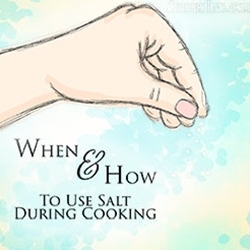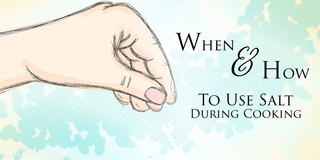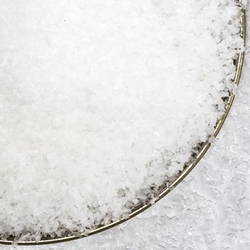
Why Add Salt to Food? The better question here is why not add salt to food? Unless you have been medically directed to limit your salt intake, you can feel good about salting food that you prepare at home. This is fresh food we are talking about here, you wouldn't want to add any more salt to something you've made from a box.
Without salt, food that doesn't taste so great will continue to taste poorly and good tasting food has the potential to feel mediocre. Of course, food can taste excellent without salt, but that's another blog post all together. Remember to exercise adding salt with caution. You want your food to be salted, not overtly salty. This is something that will take time to perfect, so be patient with yourself and make sure to consider a margin of error, just as you would with any other aspect of cooking.
Humans crave salt because it is necessary for our bodies. Salt helps with the transmission of nerve impulses, the contraction of our muscles, and the balance of fluids. Since we cannot retain salt for a long time, we must eat it regularly to keep our bodies in the best shape possible. Just like everything, consume salt in moderation.
Types of Salt
There are several types of salt, some of which you may have never heard of before. Each type has its own benefits and disadvantages.
- Table Salt- this is the salt you see in shakers all over the place. It is dense, small, and very salty. In the United States, it is usually iodized, which is something that was popularized in the 1940s due to the common health problem of iodine deficiency. Today, iodine can come from other sources, so if you want to avoid iodized salt you can. Regular table salt is also widely available, and some people think that iodized salt gives their food a metallic flavor. The size and cubic shape of table salt comes from how it crystalizes, which is usually in a manmade vacuum chamber specifically made to keep the salt uniform.
- Kosher Salt- is a salt with a larger surface area, meaning it clings to food better and dissolves better than granulated table salt. Kosher salt is excellent for everyday cooking. The practice of removing blood from meat, called koshering, is where this salt earns its name. This is the kind of salt used in the traditionally Jewish process.
- Sea Salt- When seawater evaporates, sea salt is left behind. These salts come in different shapes and sizes, depending on where, when, and how they formed. They are often harvested using low-yield, labor-intensive practices, so they tend to cost more than what table salt would cost, even though they are unrefined and less processed.
- Gourmet Salts- Now, this is not a "real" category of salt. It is just another way that people can say fancy salt, and it is usually just a subset of sea salt. This group includes Himalayan pink salt, Fleur de Sel, and Sel Gris among others. These salts are often good for finishing, meaning they are added to the end of the recipe to give texture, not necessarily flavor. Sel gris is the only obvious exception to this finishing distinction; it can be used as an everyday salt too if you are willing to pay for it.
When to Add Salt to Cooking
This depends on what exactly you are cooking and what kind of salt you are using. Salting must be done throughout the entire cooking process, it is not a one and done thing. You want to taste your dish as it cooks and add more salt over time. Remember that salt needs time to fully dissolve and permeate a dish, so it is best to learn what exactly salt will do to your food before you start to work with it.
- Meat can usually be seasoned a day before it is ready to be cooked. In fact, this is recommended. The longer you can give the seasoning or salt to make its way through the meat. If you can't season the meat a full day before you're planning on cooking it, keep in mind that the more time the better.
- Seafood is not like meat. It is too delicate to be salted in advance. Instead, salt your seafood about fifteen minutes before you're going to cook it.
- Eggs cook faster if you salt them! If you want perfectly fluffy eggs, add just a pinch of salt before you cook them if they are destined to be scrambled, omelets, or other similar foods. You will want to season fried eggs or those cooked in the shell just before serving.
- Fats don't work with salt very easily. Since salt needs water to dissolve, pure fat simply won't be conducive to dissolving salt. Things like butter can be salted, but they need time. It would be beneficial for you to first dissolve the salt in an appropriate liquid for your recipe and then apply it directly to the fat for a more even distribution.
- Vegetables contain a carbohydrate called pectin, which is not digestible to the human digestive tract. This pectin can be softened through the addition of salt. Salt your vegetables about 10 to 15 minutes to let the salt permeate the vegetables, but don't do it much earlier than that because they may become rubbery if salted too early. The salt will draw liquid out of the vegetables for as long as you will let it, so don't let it go for too long.
- Fruits are not usually something you would associate with salting, but this can help bring out the sweetness of the fruit if it is left to sit for just a few moments before consumption. Fruit also has pectin, so it does take a few moments for the salt to do its magic.
- Beans are a hard food to master. Often, they are undercooked or overcooked, and they are almost never seasoned properly. Salt can help with that. Beans, much like fruit and vegetables, are a victim to pectin's toughness. Salt does the same thing for beans and legumes as it does for fruit and vegetables. Salt your beans when you soak them before cooking. If you are not soaking the beans, you can salt them at the beginning of the cooking process.
- Dough is a finnicky brat. If you introduce it to salt, it will instantly stiffen up and act tough. This is because salt is a great friend of gluten, helping it firm up and make the dough chewier. This is necessary for a good pizza crust or pasta. If you forget to add salt and you've made your dough, you can definitely add it at the end!
- Mushrooms react to salt in a different, less favorable kind of way. Because they are predominantly water, about 80%, they will shrivel up and become limp if they are salted too early. You want to salt them after they have already browned in the pan so they can retain some of their shape.
- Pasta is something else. If you have made your own pasta, maybe you don't need to salt your pasta water. For all those who continue to buy their pasta at the grocery store, salt your water. Wait until it has boiled though, because if you add salt to a pot of cold water it'll give the salt time to interact with the pot and over time may cause damage, depending on what kind of pan you are using.
- Rice needs to be salted at the beginning of cooking as well. The rice will require less seasoning after it cooks if it has been properly salted.
Salt balances out bitterness even better than sugar does, so a pinch of salt to your pasta sauce may be a better bet than a pinch of sugar.
How Much Salt to use During Cooking
You want to use enough salt in cooking to get your food to the level where it tastes good but doesn't taste salty. This varies with every dish and every person and does require some finesse. The art of knowing when to stop is also known as "salting to taste." This is a direction you will find in every cookbook, usually void of any explanation. As a rule, salt your foods at an appropriate time for what they are and then taste as you cook. Practice makes permanent! The more you practice, the better you will understand how much salt you should use in your cooking. A pinch is always good to start with, and by a pinch we do mean an actual pinch of salt between your thumb and pointer finger. After that, seasoning is up to you. Remember that salt needs time to dissolve, so taste frequently as your cook and get excited about getting to know salt a little bit better.
Read More
The Must Have Spices for Your Kitchen


